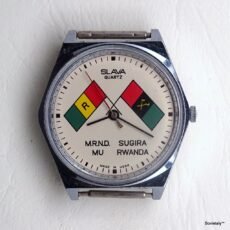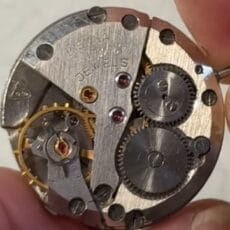Key Moments in the History of the Vympel Brand
The Birth of Vympel in the Soviet Era (1961–1964)
Vympel, whose name translates as “pennant” in Russian (Вымпел), was launched in 1961 by the First Moscow Watch Factory (1MWF), at a time when the Soviet Union was determined to prove its technical excellence not only in space but also in everyday life. The brand was named after the pennants placed on the Moon by the Luna 2 mission, and its logo reflected the space race spirit, showing a trajectory from Earth to the Moon.
The Vympel watch was developed as a dress watch—remarkably thin and refined, directly rivalling the best that Swiss and Western watchmakers could offer at the time. Its beating heart was the calibre 2209, a hand-wound movement measuring just 2.9mm thick but still featuring a central seconds hand and shock protection. With 23 jewels, it was among the thinnest and most advanced movements in the world. The entire watch, including its flat crystal, was only about 6.5mm thick—a feat that was celebrated with a gold medal at the Leipzig Fair in 1963.
Vympel watches were always classified as “1st class” timepieces according to Soviet GOST standards, and they were presented in particularly elegant packaging, with a level of finishing unusual for the time. The cases were usually gold-plated (20 microns), although some special editions were made entirely in solid gold. The dial came in three main variants, always with very thin dress-style hands and a short seconds hand—necessary due to the minimal tolerance between the dial and the flat crystal.
Despite their technical sophistication and success (even Western observers described Vympel as “by far the most elegant and thinnest mass-produced men’s wristwatch in the world” at the time), the brand was short-lived. In 1964, a reorganisation saw the First Moscow Watch Factory adopt the new Poljot brand, under which the Vympel line disappeared. However, the innovative calibre 2209 continued to be manufactured—mainly by the Luch factory in Minsk—well beyond the Soviet period, becoming the base for many other ultra-thin Soviet dress watches, some even sold under the Sekonda name abroad.
Genuine Vympel watches from this brief period (1961–1964) are now considered rare collector’s items, highly prized for their history and technical achievement.
The Post-Soviet Era: Decline and the Use of Tongji Movements
After the collapse of the Soviet Union, the Vympel name was revived in a very different context. The Vitebsk Watch Factory in Belarus, which had previously supplied cases for other Soviet brands, started producing complete watches under the Vympel brand in the 1990s. At first, these used leftover Soviet Luch movements, but as resources dwindled, the factory switched to Chinese Tongji mechanical movements. The Tongji movement, standardised in China since the 1970s, was inexpensive and easy to source, but lacked the technical prestige of the original Soviet calibre 2209.
As a result, post-Soviet Vympel watches are far less refined than their predecessors. The use of Chinese movements, often identifiable by the “double pennant” Vympel logo stamped on the bridge, marked a clear break with the original ethos of the brand. By the early 2000s, the Vitebsk factory was in serious decline, and production of both complete watches and spare parts was almost entirely discontinued.
Collector’s Notes and Cautions
A word of warning for collectors: many watches labelled as Vympel found on the secondary market are not original 1960s pieces. Forums such as Watchuseek and Watch.ru frequently report examples of “Frankenwatches”—timepieces assembled from mismatched parts and falsely sold as authentic Vympels. Additionally, it is common to see any ultra-thin Soviet watch with a 2209 calibre (even if made by Luch, Poljot, or other brands) incorrectly described as a Vympel.
True Soviet Vympel watches remain rare and desirable, while post-Soviet models, particularly those with Tongji movements, are best regarded as a separate, less prestigious chapter in the history of the brand.
Sources:
(Watches of the USSR: https://mroatman.wixsite.com/watches-of-the-ussr/vympel),
(Watchuseek: https://www.watchuseek.com/threads/vympel-watch.4645513/),
(Watch.ru: https://forum.watch.ru/showthread.php?t=10399),
(SafonaGastroCrono: https://www.safonagastrocrono.club/poljot-2209-vympel-english/),
(Watch-Wiki: https://watch-wiki.org/index.php?title=Vympel)



